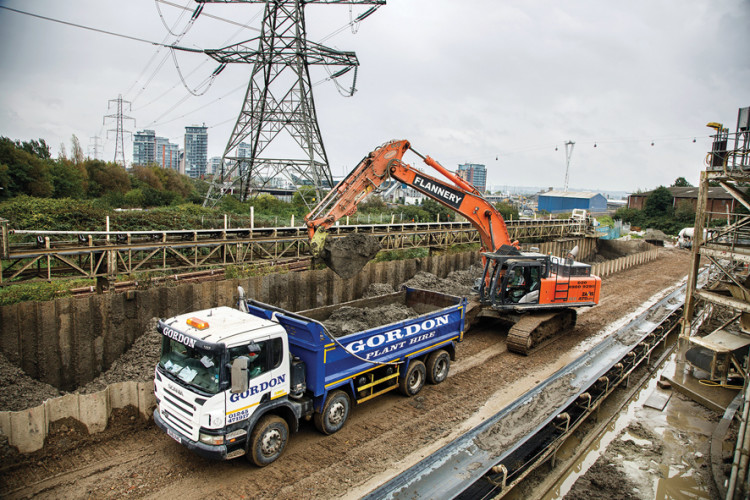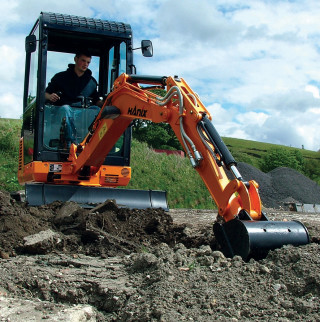After a year of growth there are signs that the long climb out of the recessionary depths may be losing momentum; there are even fears that it may stall altogether. The major source of good news over the past 18 months has been the extraordinary surge in private house-building activity and profitability, but even this juggernaut went into reverse in August, registering a 5.5% fall in output compared to July 2014 according to the Office for National Statistics.
Overall, the construction industry’s output was 3.9% down on the July 2014 figure and it was even down (although only marginally) against August 2013. This was the first time since May 2013 that there has been a yearon- year fall. Concerns about the situation were reflected in a survey by the Scottish Building Federation published at the end of September which revealed that Scottish construction bosses remained moderately optimistic about prospects but not nearly so much as they had been at the end of June. Their caution may also reflect the inexorable rise of input costs, which rose 6% in the second quarter, and worsening skill shortages.
The August setback may turn out to be a blip - only time will tell. A more positive sign came from the statistics published by Barbour ABI for commercial and retail construction contract awards which almost doubled in August compared to a year ago. Winning work is of course one thing, but doubts about profit margins persist. Plant hire companies will always be a barometer of overall construction activity; little happens without their involvement. The companies we analysed are those with turnover of £25m or more in their latest published accounts. The sample totalled 25 UK-based companies, although it should be noted that some of them such as Aggreko and Ashtead earn the majority of their revenues abroad, while some others, such as Lavendon have substantial international operations.
Wherever possible we have excluded companies that operate only as internal hirers within a larger group. Equally we have been unable to disentangle the plant hire operations from within the overall figures for some complex construction groups, especially some foreign-owned entities. A further caveat is the inclusion of Harsco Infrastructure, which disposed of its business and assets in November 2013. The successor entity, Brand Energy & Infrastructure has yet to file any accounts for its UK operations, so the data in this year’s table is historic in this one specific regard.
The level of profitability revealed by the Company Watch research data on the financial status of leading UK plant hirers is significantly higher than any of the other sub-sectors featured in our previous reports. Overall, their margins edged up from 14.7% to 14.9% on reported turnover, which compares with less than 4% for utility & water contractors, scaffolders, demolition specialists, road builders, M&E experts and commercial contractors. Only house builders come anywhere near, showing 9.7% when we analysed their results almost a year ago.
Profit margins at these levels are the reward for a far heavier commitment to fixed asset investment than that required of most other construction enterprises. The 25 companies in our study have average borrowing equivalent to 79% of their net worth, a slight increase on last year’s 78%. This compares with gearing of 51% for scaffolders and 39% for the leading commercial builders, 31% for road builders, a mere 7% for M&E contractors and 5% for utility and water contractors. Only one of the plant hirers has a debt-free balance sheet, compared to over half of M&E contractors and commercial builders. Debt is a way of life in the plant hire industry but it helps these large players to earn a highly respectable 26% on the net capital they employ, again slightly up on last year when the return was 25%.
Looking next at the overall financial health of our sample of 25 plant hire companies, their average Company Watch HScore is 59, which comfortably exceeds the norm of 49 for all UK companies of similar size. This shows a significant improvement over the past twelve months; the equivalent figure last year was 55. This is the best score we have found across the eight sectors that we analyse each year for The Construction Index.
Plant Hire Companies
| Company name | Total assets £m | Total debt £m | Net worth £m | Annual sales £m | Pre-tax profit £m |
Financial heal score (Max 100) |
| Andrews sykes | 62.8 | 8.3 | 43.8 | 61.1 | 15 | 98 |
| MGF | 47 | 3.3 | 38.1 | 26.3 | 7.6 | 97 |
| Mabey hire | 42.8 | 0 | 36.1 | 37.7 | 6.7 | 95 |
| Aggreko | 1,989 | 575 | 972 | 1,573 | 333 | 9 |
| Ainscough crane hire | 251.4 | 83 | 141.3 | 109.4 | 10.4 | 85 |
| Ashtead group | 2,666.3 | 1,151.4 | 824.4 | 1,634.7 | 356.5 | 85 |
| Charles wilson engineers | 46.5 | 4.6 | 30 | 33.7 | 4.3 | 74 |
| L lynch | 11.5 | 2.2 | 4.6 | 35.4 | 2.4 | 73 |
| Select plant hire | 242.2 | 78.8 | 113.6 | 194.8 | 11.2 | 71 |
| Deborah services | 71 | 0.9 | 27.7 | 99.4 | 7.2 | 68 |
| Generation | 45.8 | 2.7 | 25.1 | 46.3 | 5.2 | 68 |
| Lavendon | 390.2 | 117.1 | 211.2 | 237.5 | 23.4 | 68 |
| Selwood | 69.3 | 30.3 | 20.9 | 56.2 | 9.9 | 59 |
| HSS hire service | 202.2 | 8.4 | 62 | 225.8 | 20.4 | 57 |
| GAP group | 150.7 | 57.2 | 57.4 | 118.4 | 13.5 | 57 |
| VP | 218.9 | 62 | 108 | 183.1 | 18.9 | 57 |
| Quattro plant | 32.3 | 20.2 | 7.1 | 40 | 3.3 | 46 |
| Speedy hire | 418.2 | 87.1 | 239.3 | 349.7 | 7 | 45 |
| John nixon | 49.3 | 28.1 | 13.6 | 36 | 2.4 | 40 |
| Brandon hire group | 51.7 | 34.3 | 4.7 | 75 | 2 | 36 |
| Go plant | 24 | 6.8 | 11.4 | 30.7 | 0.6 | 36 |
| Owen pugh | 17.7 | 6.2 | 4.3 | 32 | 0.6 | 32 |
| Hewden | 232.4 | 71.2 | 120.1 | 95.4 | -13.1 | 23 |
| Clive barford | 23.1 | 5.7 | 6.4 | 31.4 | 0.1 | 16 |
| Harsco infrastructure services | 16.7 | 13.7 | -23.6 | 61.9 | -42.9 | 4 |
| Totals | 7,373 | 2,458.5 | 3,099.5 | 5,424.9 | 805.6 | |
| Averages | 294.9 | 98.3 | 124 | 217 | 32.2 | 59 |
| Average gearing ratio | 79% | |||||
| Average profit margin | 14.9% | |||||
| Return on capital | 26% |
Sector Comparisons
| Profit margin | Return on capital | % gearing | % with no borrowings | Average health score | % in warning area | |
| House builders | 9.7% | 11% | 23% | 22% | 45 | 28% |
| Utilities & water contractors | 1.8% | 12% | 5% | 33% | 56 | 4% |
| Scaffolding contractors | -4.4% | -21% | 51% | 21% | 54 | 26% |
| Demolition contractors | 3.6% | 15% | 39% | 16% | 49 | 4% |
| Road builders | 3.2% | 26% | 31% | 34% | 56 | 8% |
| Commercial contractors | 1.8% | 13% | 17% | 50% | 52 | 5% |
| M&E contractors | 1% | 7% | 7% | 60% | 52 | 9% |
| Plant hirers | 14.9% | 26% | 79% | 4% | 59 | 8% |
The full details of the sector comparisons appear in a separate table in this feature. The further good news is that just two of the companies (representing 8% of the sample) are in the Company Watch warning area. Across the whole UK economy, we would expect that around 25% of any sample would be in this financial twilight zone. Looking at the better performers, 64% of the sample have H-Scores of 51 and above, as compared to around 50% for all UK companies.
Almost the entire sample has avoided the two major potentially adverse factors. Only one has negative net worth and just two are loss-making. Unsurprisingly, these laggards occupy two of the bottom three places in our H-score league table. The results of our research are certainly encouraging, but it is worth repeating the usual mantra - that our research covers only the major players out of a highly fragmented market, dominated by thousands of much smaller, generally undercapitalised and almost exclusively family-owned SMEs or sole traders. Inevitably the bulk of these companies are less strong financially and too often the victims of the supply chain squeeze and late payment culture, which continue to stain the reputation of the industry. Commercial life for these foot soldiers of the plant hire world will always be more precarious.
One of the realities of any growth phase after a recession is that insolvencies tend to peak between 15 and 18 months after sustained recovery has become established. The counter-intuitive reason for this is that surviving companies tend to burn through their reserves during the recession and then struggle to raise the extra working capital they need to fund increased sales and investment as things pick up.
This effect is likely to be particularly marked this time round, because the financial services sector was so badly affected. Many banks and other lenders are still rebuilding their own balance sheets and battling to satisfy the enhanced capital adequacy ratios that regulators have quite rightly imposed on them to reduce the risk of another financial meltdown. The banks therefore have less money to lend, especially for working capital, and will be far choosier about who they will help to expand in the coming months and years. The alternatives, especially the more novel ones such as crowd funding, may prove difficult for small and unsophisticated plant hire firms to access. And because many are highly dependent on one or two major contractors for their work, securing receivables financing – using money owed as collateral - is also problematic. So while the finances of our major plant hire businesses have improved across all measures over the past year, we must be cautious about the future for the sector as a whole. Although formal insolvency numbers continue to fall, this trend may not continue indefinitely. Any sustained slowing across construction as a whole is likely to hit plant hirers hard, but further growth may be equally dangerous.
Got a story? Email news@theconstructionindex.co.uk




